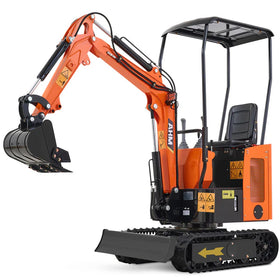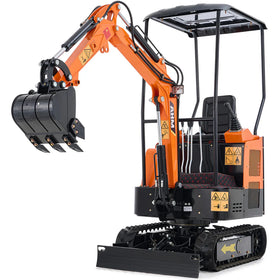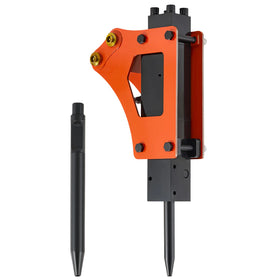Trench cave-ins can happen in seconds, burying workers under thousands of pounds of soil with little warning.
According to OSHA statistics, trench collapses cause dozens of worker fatalities each year, making them one of the deadliest hazards on construction sites. Every construction team must know the proper protection methods against cave-ins to prevent these tragic accidents. This guide explains the three OSHA-approved protection methods that can save lives on your excavation site.
Who Needs to Know About Trench Protection Methods?
Anyone working around trenches should understand these safety systems. Construction supervisors, excavation crews, utility workers, and safety managers all need this knowledge. Even property owners who hire contractors should verify proper safety methods are being used. Understanding trench protection isn't just about compliance—it's about making sure everyone goes home safely after work.
OSHA Requirements for Trench Safety

OSHA requires protective systems for all trenches deeper than 5 feet. The only exception is when the excavation is made entirely in stable rock. A "competent person" must inspect trenches daily before work begins and after any condition changes.
What is an OSHA "Competent Person"?
A competent person has specific training to identify existing and predictable hazards. They must be able to classify soil types and select appropriate protective systems. This person needs authority to take prompt corrective measures when unsafe conditions exist. The competent person must inspect the trench before each shift and after any event that might increase hazards, like a rainstorm.
Soil Classification Basics
The kind of soil you're digging in affects which safety method works best. Think of soil in three main types: Type A is like firm clay that holds its shape when you dig. Type B is somewhat crumbly but still holds together mostly. Type C is loose like sand or gravel - it falls apart easily. The looser your soil, the more protection you'll need.
Soil Classification and Required Slopes for Trench Safety
|
Soil Type |
Description |
Maximum Slope Ratio |
Angle from Horizontal |
|
Stable Rock |
Natural solid mineral that remains intact when exposed |
Vertical (90°) |
90 degrees |
|
Type A |
Cohesive soils: clay, silty clay, sandy clay, clay loam |
¾:1 (0.75 horizontal to 1 vertical) |
53 degrees |
|
Type B |
Silt, sandy loam, unstable dry rock, previously disturbed soils |
1:1 (1 horizontal to 1 vertical) |
45 degrees |
|
Type C |
Granular soils: gravel, sand, loamy sand, submerged soil |
1½:1 (1.5 horizontal to 1 vertical) |
34 degrees |

The Three Main Protection Methods Against Cave-ins
1. Sloping and Benching Systems

When we dig a trench, the walls can fall in if they're straight up and down. Sloping means cutting the walls at an angle instead of straight up, like the sides of a wide "V". The looser your soil, the wider this "V" needs to be.
For clay-type soil (Type A), you need to cut back about 9 inches for every foot of depth. For mixed soils (Type B), you need to cut back a foot for every foot of depth. For sandy or loose soil (Type C), you need to cut back a foot and a half for every foot down you dig.
How to check your soil:
Here's a simple test anyone can use: Dig a small hole about two feet deep using a shovel. Watch it for about 20 minutes. If the sides stay firm without crumbling, you probably have more stable soil. If it starts crumbling right away, you're dealing with loose soil that will need more protection.
Step-cutting option:
Benching is like cutting stairs into the side of your trench instead of a smooth angle. Think of it as giant steps going down into the trench.
This method saves about a quarter of the digging compared to sloping, which helps when you don't have much space to work with. Remember though - you can only use this stair-step method in firmer soils, not in sandy or loose materials.
2. Shoring Systems
Shoring is like putting braces against the trench walls to keep them from falling in. Imagine putting your hands against the walls of a sandcastle to keep them from collapsing - shoring works on the same idea, but with strong supports.
The most common type uses metal plates or plywood sheets held against the trench walls by hydraulic pistons (think of them as strong metal arms that push outward). These supports are placed along the walls of your trench to hold back the soil.
When to use shoring:
Shoring is perfect when you don't have much space around your trench. If you're digging near a building, under a driveway, or in a tight backyard, you might not have room for sloping. Shoring takes up less space above ground while still keeping workers safe below.
Setting up shoring:
Some shoring systems can be heavy, with pieces weighing up to 85 pounds. Look for systems with snap-together connections instead of bolt-on parts - they can save nearly half the setup time. Many contractors find that smaller, lighter shoring systems work well for typical home and small business projects.
3. Trench Shields (Trench Boxes)

Think of a trench shield (or trench box) as a strong protective shell that keeps workers safe. It doesn't stop the trench walls from collapsing, but it creates a safe zone inside where falling soil can't reach workers.
A trench shield has two solid walls (usually metal) connected by strong crossbars called spreaders. Workers stay inside this protective box while doing their job. As work moves along the trench, the shield moves with them.
When to use shields:
Shields work great for projects that move along in a line, like laying pipe or cable. They're especially useful when you're working in loose soil or when the trench will only be open for a short time. You can dig the trench, place the shield, do the work, and fill it back in section by section.
Choosing the right shield:
Shields come in different sizes. Smaller ones weighing under 1,100 pounds are good for trenches 8-10 feet deep. These lighter shields can be moved more easily as your work progresses. Always keep equipment at least 18 inches (about the length of your forearm) away from the edge of the trench when moving shields.
"We installed a drainage system along a property line last summer using a trench shield," says Tom Wilson, who's been installing utility lines for 15 years. "The soil was pretty sandy, so it would have been dangerous to work without protection. We moved our shield along as we laid each section of pipe. It added about 30 minutes to our setup time, but that's nothing compared to the safety it provided. One section did have a small collapse while we were working, but nobody got hurt because we were all inside the shield."
Additional Safety Requirements

Easy Access In and Out
For any trench 4 feet or deeper, you need a way for workers to get in and out quickly. Place ladders, ramps, or steps within 25 feet of workers in the trench. That way, no one has to run far to exit in an emergency. Make sure ladders stick up at least 3 feet above the trench edge so workers have something to hold while climbing out.
Keep Heavy Stuff Away from the Edge
Keep the dirt you've dug out (called spoil) at least 2 feet away from the edge of the trench. Think of this as creating a "no pile zone" around your trench. The weight of soil, tools, or equipment too close to the edge can cause the walls to cave in. Use boards, caution tape, or cones to mark this safety zone.
Water Makes Trenches Dangerous
Water in a trench makes cave-ins much more likely. Never let workers enter a trench with standing water. Use pumps to remove water, and stop work if it's raining heavily. If the ground is wet from previous rain, be extra careful and check the trench walls more frequently. Learn more about water management on construction sites for additional guidance.
Choosing the Right Equipment for Trench Protection

The equipment you use can make a big difference in how effectively you implement these protection methods. For smaller projects, compact equipment like mini excavators can create properly sloped trenches while working in tight spaces. These smaller machines offer great maneuverability and can help prevent surrounding soil disturbance.
When using sloping techniques, having the right excavation equipment makes the job much easier and safer. Equipment with precise bucket control allows for more accurate sloping angles. For trench shield installation, make sure your equipment can safely handle the weight of your chosen shield system.
Further reading: How to Dig a French Drain with Mini Excavator
Trench Safety Checklist
Follow this quick checklist before beginning work:
- Competent person has inspected the trench
- Proper protection method is in place for the depth and soil type
- Safe access/egress is within 25 feet of all workers
- Spoil piles are at least 2 feet from trench edge
- No standing water is present in the trench
- Underground utilities have been located and marked
Common Mistakes to Avoid
Many preventable accidents happen due to these common errors:
- Taking shortcuts on protection systems endangers lives.
- Using the wrong protection method for your soil type creates false security.
- Failing to address water problems quickly leads to dangerous conditions.
- Neglecting daily inspections by a competent person is another major oversight.
Frequently Asked Questions About Trench Protection
How deep can I dig before needing cave-in protection?
OSHA requires protective systems for all trenches deeper than 5 feet unless you're digging entirely in solid rock. However, a competent person may determine that protection is needed for shallower trenches if soil conditions are unstable.
Which protection method is most cost-effective for short-term projects?
For short-term projects in stable soil, trench shields are often most cost-effective because they can be rented for short periods and require minimal setup time compared to shoring systems.
How does weather affect trench stability and protection requirements?
Weather significantly impacts trench stability. Rain can quickly turn stable soil into an unstable condition. After any rainfall, your competent person must re-inspect the trench before work resumes, and you may need to upgrade your protection method.
Can different protection methods be used on the same project?
Yes! You might use sloping where space allows and shields in tighter sections of the same trench. The key is making sure workers are protected at all times, regardless of which section they're working in.
Is benching or sloping better for clay soil?
Both methods work well in clay (Type A) soil. Sloping requires more excavation but creates a smoother work area. Benching saves about 23% in excavation volume but creates stepped surfaces. Choose based on your specific space constraints and equipment.
Can I rent trench shields for a weekend project?
Yes, many equipment rental companies offer trench shields for short-term projects. Be sure to specify your trench depth and width when renting to get the right size shield for your job.
Conclusion
Choosing the right protection method against cave-ins saves lives. Whether using sloping, shoring, or shields, proper implementation is crucial. Always follow OSHA guidelines and listen to your competent person's direction. The few extra minutes spent on safety can prevent devastating accidents and keep your team protected.







